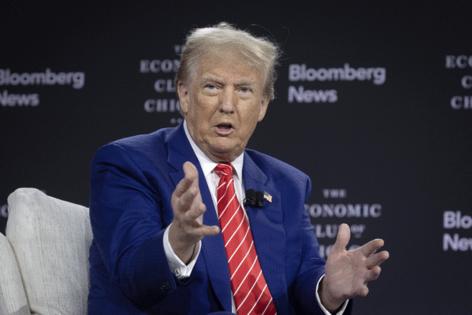Trump can tap the brakes on the EV revolution, but not stop it
Published in Business News
Tim Echols is a bona fide a conservative. The Georgia public service commissioner is an ordained evangelical minister, is solidly against abortion and founded a nonprofit to help teens understand the political process and “defend their Christian faith.”
But there’s one place where he’s a little out of step with his political colleagues: Echols is also evangelical about electric vehicles. The guy loves them, owns three and is on a crusade to get fellow conservatives on board. That’s why the Echols’ family Nissan Leaf is often out on loan to a Georgia politician.
“I think a lot of Republicans have kind of written off electric vehicles without giving them a chance, without owning one,” Echols explained. “I feel like I’m winning hearts and minds, one legislator at a time.”
To be sure, it’s an easier case to make in Georgia: A tide of federal incentives has brought a windfall of industrial jobs making electric vehicles and the parts to build them. Echols, however, is concerned that tide may turn if Donald Trump wins back the White House.
When Trump sat down with Bloomberg Businessweek in June, he offered a convoluted take on battery-powered cars. “I have no objection to the electric vehicle,” he said, while immediately airing a laundry list of objections, including cost and range.
In the months since, EVs have been parked squarely in the presidential candidate’s stump speech with a serial promise to “end the electric vehicle mandate on day one” — though the Biden administration hasn’t set a mandate. (It does have a goal of half of new car sales being electric by 2030, though).
Trump has been vague about how his would-be administration would pump the brakes on EVs. But auto and policy experts see the possible trajectory of battery-powered machines in a Trump White House 2.0. There are several levers the executive office could pull. Yet they’ll likely have little impact on EV sales and companies rolling out new models.
“At this point, the transition is inevitable,” said Nick Nigro, founder of Atlas Public Policy, a policy-focused consultancy. “There’s no stopping it, and while slowing it down might improve near-term returns for some companies, it’s going to hurt the long-term prospects for any company.”
Here’s a look at where a second Trump administration may try to steer EVs.
$7,500 at a time
Nigro and others say the easiest EV target to hit from the Oval Office would be consumer incentives, specifically tax rebates worth up to $7,500 per vehicle afforded by the Inflation Reduction Act. Even if there isn’t enough support in Congress to overturn the legislation entirely, Trump could make the credits harder to qualify for by putting stricter limits on where various parts and pieces are sourced from, according to James Lucier, managing director at research group Capital Alpha Partners. A second Trump administration could also unilaterally cancel tax credits for leased electric vehicles.
The White House, however, has no control over the incentives being doled out by states and utilities concerned about climate change and clean air. There are 17 states offering financial incentives for EVs, some of which outstrip the federal payout. Colorado drivers, for example, can get $5,000 for purchasing a battery-powered vehicle and $6,000 for trading in a gas car.
Nor does the White House have much sway in influencing the sticker price of EVs, which auto executives are bent on bringing down. Since the Inflation Reduction Act was signed in August 2022, the average price of an electric vehicle has dropped by 7.4%, according to Edmunds.com.
While the average EV is still more expensive than the typical gas car, that’s largely because car companies have largely focused on churning out luxury models. There is now a parade of EVs in America that cost less than the average gas car.
“For me and for millions of Americans, electric vehicles are removing daily hassles and reminding us why we love to drive,” that’s from battery-powered vehicle fan Jim Farley, who also happens to run Ford Motor Co.
Indeed, battery-powered whips are generally sportier to drive, cheaper to maintain and no longer much of a liability on long road trips. In the U.S., there are now more than 30 electric vehicles that travel more than 300 miles on a charge and a growing number of charging stations.
Auto CEOs “know this is the future because the product is superior,” said Rick Wilmer, CEO of ChargePoint Holdings, an EV fueling network. “To me, whether it’s a Democratic or Republican administration, it’s either a little bump in the road or a little accelerator in the road. But no matter what happens, it’s not a big thing.”
Shuttering factories
Trump has promised to rescind or redirect unspent industrial EV incentives afforded by IRA. Any such efforts, though, are likely to run into opposition from his fellow Republican lawmakers — including Georgia’s Echols — and auto executives who have already pledged billions to the EV transition.
Car companies and their suppliers have committed $312 billion to build or expand 485 U.S. factories and facilities dedicated to making electric cars and their components, according to Atlas Public Policy. That spending is tied to 285,000 jobs. Look at a map of those plants, and you’ll see clusters in red districts and battleground states in the Midwest and Southeast.
Trump’s stump speech these days often includes a zinger about EVs: “They’re all made in China.” However, nearly three in four electric vehicles purchased in the U.S. in the second quarter were made in the U.S., including the Acura ZDX, Ford F-150 Lightning, Mercedes EQE, Volkswagen ID.4 and Tesla Model Y, the best-selling electric vehicle in the world.
Indeed, some GOP lawmakers are already maneuvering to protect incentives for the EV economy in their districts. House Speaker Mike Johnson received a letter in August signed by 18 Republican lawmakers urging him not to mess with the clean technology subsidies embedded in the Inflation Reduction Act, a law that half of them voted against (the other nine are freshmen elected a few months after it passed).
“These are huge investments,” explained Albert Gore, executive director of the Zero Emission Transportation Association. “It’s not a viable political position to be against more economic opportunity for the folks in your city or state.”
Capping clean air
Perhaps Trump’s largest EV lever would be to repeal new air pollution limits issued by the Environmental Protection Agency in March, which oil industry groups say illegally force automakers to sell electric cars and 25 Republican-led states have challenged in court.
Trump rolled back fuel-efficiency standards from the Oval Office in 2020. Auto executives, however, are increasingly tooling their product line for stricter regulations in California — where more than one in 10 U.S. vehicles are sold — and the 13 states that mirror the Golden State’s clean air policies. Car companies are also tweaking powertrain decisions for buyers in China and Europe where the transition to electric vehicles is further along due to a mix of more stringent regulations and more generous subsidies.
“Automakers have invested so much, they’re not going to want to go back,” said Elaine Buckberg, chief economist of General Motors until 2023. “And every major automaker is in at least two of the three major EV markets.”
If she were still modeling sales estimates at GM, a Trump victory in November would compel Buckberg to tick her EV forecast “somewhat lower,” but not drastically. “All the concerns people have (about EVs),” she explained, from cost to range to charging infrastructure, “are getting addressed.”
Meanwhile, down in Georgia, Echols plans to lobby to keep IRA incentives and continue his EV crusade. In fact, he wants to integrate EVs even further into daily life by standing up a large-scale program for feeding electricity back onto the grid during peak demand. He’s hoping his Republican colleagues can see the upsides, including cleaner air, a more flexible grid, lower electricity rates and energy independence.
©2024 Bloomberg L.P. Visit bloomberg.com. Distributed by Tribune Content Agency, LLC.












Comments